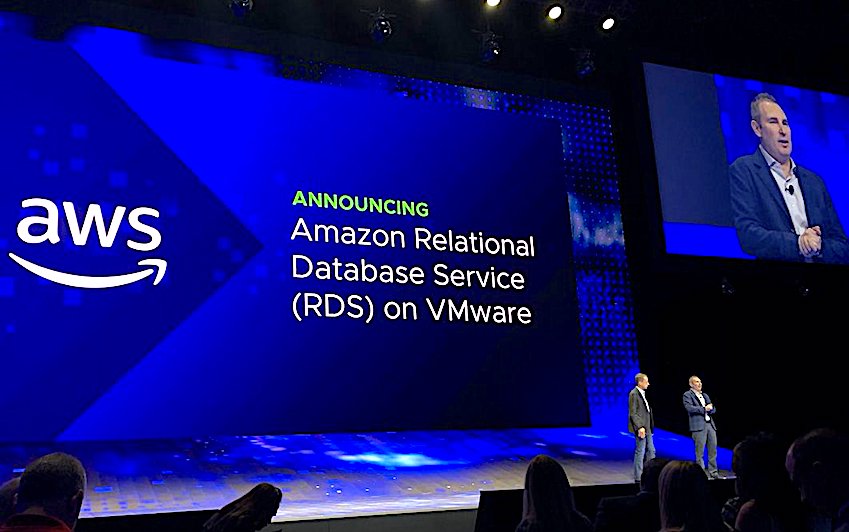 CLOUD
CLOUD
 CLOUD
CLOUD
 CLOUD
CLOUD
Updated:
On the eve of this week’s VMworld in Las Vegas, conference host VMware Inc. Sunday night debuted several new technologies and some lower prices for its cloud software suite atop Amazon Web Services Inc.
The new services are an expansion of VMware Cloud on AWS launched a year ago. At VMworld. They’re aimed at making even easier for enterprises to move applications and computing workloads between VMware’s vRealize Suite of software, which manages hybrid clouds that span on-premises data centers and public cloud services, and AWS’ cloud services, specifically its Elastic Compute Cloud computing services.
VMware Cloud on AWS enables the huge number of companies that use VMware, whose “virtual machine” software allows different operating systems and multiple applications to run on the same physical computers inside their data centers, to run on AWS services as well.
First, VMware announced that Vmware Cloud on AWS is now available in AWS’ Asia Pacific cloud region in Sydney, Australia. That means the service now can run in any AWS region in the world, a key consideration for multinational companies with data compliance requirements.
“The top ask from our customers is more regional availability” Sandy Carter, AWS’s vice president for EC2 Windows Enterprise Workloads, said in a briefing last week. “Banks have been waiting for Sydney to become available,” for example.
VMware and AWS also announced a series of new updates. Chief among them is a 50 percent lower entry price on a new, smaller minimum configuration for the service. The lower price will be on a three-host minimum configuration.
“Customers wanted a smaller starting size than four hosts,” said Mark Lohmeyer, senior vice president and general manager of VMware’s Cloud Platform Business Unit.
Update: In a surprise announcement Monday morning, AWS Chief Executive Andy Jassy (pictured, right, with VMware CEO Pat Gelsinger) said the Amazon.com Inc. cloud unit is making its widely used RDS relational database services available on-premises VMware’s vSphere suite of software as well as in AWS’ public cloud. “Managing the administrative and operational muck of databases is hard work, error-prone, and resource intensive,” said Jassy. “It’s why hundreds of thousands of customers trust Amazon RDS to manage their databases at scale.”
A shot at longtime database market leader Oracle Corp., Amazon RDS on VMware is intended to make it easier for customers to operate databases in VMware-based software-defined data centers and hybrid cloud environments and also to migrate them to AWS or VMware Cloud on AWS. It’s expected to be available in the next few months, and in coming months it will also support Oracle, Microsoft SQL Server, PostgreSQL, MySQL and MariaDB databases.
Another new feature is allowing customers to adjust the number of processor cores to enterprise licensing needs for Microsoft Corp. and Oracle Corp. software. There’s also a new high-capacity storage option that use AWS’ Elastic Block Storage service to allow more cost-effective scaling-up for key workloads without having to scale up the computing services along with it, which cost more.
In addition, there’s a new ability to do live migration of thousands of virtual machines to the cloud with no downtime and also use VMware’s NSX Hybrid Connect to schedule when to cut over to the cloud. And there’s a new integration of NSX and AWS’ Direct Connect, which provides private connectivity between AWS and a datacenter, office or rented server space known as colocation to speed bandwidth and reduce costs.
The two companies outlined a trio of use cases emerging for VMware Cloud on AWS. They include cloud migrations, naturally, but also expanding data centers with on-demand capacity in the cloud and disaster recovery. PHH Mortgage, for instance, migrated 350 virtual machines to AWS in a few days so it could shut down a secondary disaster recovery site. For another, the U.K. bus and train network Stagecoach moved its VMware environment for critical applications such as scheduling and managing employees to the cloud.
Although some analysts had expected VMware Cloud on AWS to spur a wholesale move from on-premises VMware software to AWS’ cloud, that hasn’t happened yet. “VMware customers are happy with the vSphere and other VMware management tools, David Floyer, an analyst with SiliconANGLE sister company Wikibon, said in a new report on VMware’s strategy. Indeed, he noted, some customers have developed new cloud applications on AWS and moved them to on-premises servers to reduce latency and data movement costs.
“The latest round of enhancements to the core VMware Cloud on AWS offering further demonstrate AWS’ commitment to the partnership,” said Wikibon analyst James Kobielus. “VMware has not wasted time integrating its entire virtualization solution portfolio into the AWS cloud.”
However, he added that there’s a gap in similarly deep partnerships with other cloud companies. “VMware has inexplicably has not deepened its integration along equivalent lines with Microsoft Azure, Google Cloud Platform, IBM Cloud, or other public cloud providers,” he said.
VMware’s expected to announce a raft other other new services starting Monday in Las Vegas. Now in its 15th year, VMworld has become one of the go-to conferences for companies looking ways to move further and faster into the cloud without having to give up the stability of their VMware deployments in their own data centers.
Support our mission to keep content open and free by engaging with theCUBE community. Join theCUBE’s Alumni Trust Network, where technology leaders connect, share intelligence and create opportunities.
Founded by tech visionaries John Furrier and Dave Vellante, SiliconANGLE Media has built a dynamic ecosystem of industry-leading digital media brands that reach 15+ million elite tech professionals. Our new proprietary theCUBE AI Video Cloud is breaking ground in audience interaction, leveraging theCUBEai.com neural network to help technology companies make data-driven decisions and stay at the forefront of industry conversations.